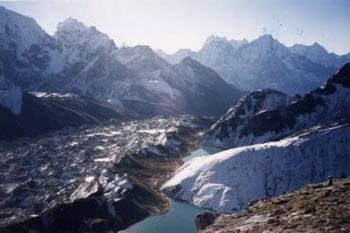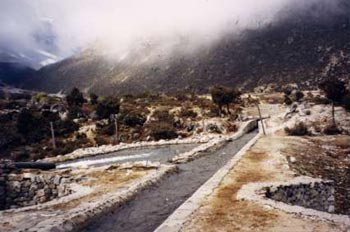Himalayan Hydropower
Air Date: Week of September 10, 2004
The mountains of Nepal funnel water to some of the most powerful rivers in southern Asia. Now, despite environmental and financial concerns, small-scale hydropower projects are supplying electricity to Nepalese villages, Buddhist temples and even Internet cafes. Reporter Cheryl Colopy has our story.
Transcript
CURWOOD: It’s Living on Earth. I’m Steve Curwood.
Building new dams to generate electric power doesn’t happen much these days in the U.S. Concern for migrating fish and the potential for damaging rivers seem to trump the need for electricity. But, in the kingdom of Nepal in the Himalyas, it’s a different story.
Waters from the highest mountains in the world feed some of south Asia's most powerful rivers – rivers that can be dammed and their energy harnessed. And while environmental concerns and the high cost of construction have shelved plans for several large dams in recent years in Nepal, small- scale hydropower projects are flourishing.
Locally managed dams in some Nepali villages are bringing electricity to remote areas and lighting up schools, Buddhist temples, even Internet cafes. But with global climate change, even these small-scale dams face big environmental risks. Cheryl Colopy has our story.
COLOPY: Nepal is the birthplace of the Buddha, and visitors praise the nation’s culture and architecture as “rich.” Yet this is one of the poorest countries in the world. In terms of natural resources, it has one.
[BUBBLING STREAM]
COLOPY: From the whisper of little streams to the roar of rock-laden rivers full of glacial melt, this is the music of Nepal.
[RUSHING WATER]
COLOPY: Yet, with some of the highest peaks in the world and all this water available to generate hydropower, fewer than one in four Nepalis has access to electricity.
[SOUND OF BUSY STREET]
COLOPY: Even here in the capital, Kathmandu, power can be intermittent. Arun Shrestha is an engineer with Nepal’s Department of Hydrology and Meteorology. The electricity in his office has been going on and off all morning.
[OFFICE SOUNDS]
SHRESTHA: We say water is our wealth, and the dream of the nation is to, somehow, harness this wild running water, convert it to energy and do whatever you want to do, you know?
COLOPY: Shrestha laughs as if to say, “If only it were that easy.” In theory, there are up to a quarter of a million megawatts of potential hydropower in the Himalaya. That’s enough to supply two Indias. But earthquakes, sediments, lack of roads and many other challenges stand in the way of turning water into electricity. And most plans depend on neighboring India’s buying the megawatts at a high enough price to justify the effort.
Several years ago, a coalition of environmentalists and economists defeated a major World Bank project. Since then, no large dams have moved past the planning stage. Former Water Minister Dipak Gyawali was one of those opposed. He says big dams mean big debt.
GYAWALI: The issue is risk. Is it a large risk or a small risk? And who’s bearing it? And for the person or community bearing it, even a so-called small project might be a very large risk.
COLOPY: Gyawali does see a future for smaller, Nepali-financed projects like several recently completed ones that are now feeding the grid. He’s one of a group of well-traveled and highly educated water specialists in Nepal who are seeking technological progress that's closely tied to social benefit.
GYAWALI: And don’t give us this pie-in-the-sky kind of argument – “Oh, you’ll build this huge project and suddenly, you know, you can export all the electricity and get a lot of money and build your schools and hospitals and all that.” Now, if Nepal had six to ten billion dollars, would it build this 10,000 megawatt monster, or invest in 200 other things needed in development?
COLOPY: Over at the offices of Nepal Electricity Authority, Managing Director Janak Lal Karmacharya sees it differently. He’s championed some of the large hydro projects, and he still hopes they'll happen. After all, the melting snows are still there. Demand and financing could still come together, he says.
KARMACHARYA: The water is always available. It’s a question of when it should be developed. That means when the market is ready to take that form of energy. So, you know, everything is decided through the market, not philosophy.
COLOPY: The debate continues, and large dams may some day be built in Nepal. But, meanwhile, far from the capital, an array of medium, mini and micro-hydro is serving other cities, and even many of the remote villages in Nepal.
[DINING ROOM SOUNDS]
COLOPY: In the dining room at the Panorama View Lodge, in the popular tourist crossroads of Namche Bazaar, an international clientele enjoys bright lights, hot water and flush toilets thanks to hydropower.
[SQUEAKING DOOR]
|
COLOPY: At 11,500 feet, Namche is where trekkers must spend a couple of days to get used to the thinning air before proceeding higher. Adventuresome tourists discovered this region -- known as the Khumbu -- in the 1970s. Guesthouses sprang up. Soon, the wooded hillsides around Namche were denuded for building and fuel. Local Sherpa people and their western friends sought an alternative fuel, fearing there would be no forests left. Sherap Jangbu Sherpa is the owner of the Panorama View. For the past ten years he’s used electricity from one of the highest hydropower plants in the world. S.J. SHERPA: When we started the lodge, we used to bake the cakes in a pan and we maybe used almost 20 kilos or 30 kilos of wood just to bake a cake. And now, it hardly costs about maybe 13 or 14 rupees with the electric. It doesn’t cost anything, and it is much easier, so electricity made life very good [KITCHEN SOUNDS] COLOPY: Sherap points out all the appliances electricity allows him to use to keep tourists happy. S.J. SHERPA: Yeah, we couldn’t have refrigerator, microwave, the oven, the toaster, egg cooker, the boiler for washing dishes, and, also, we got another boiler up there for shower. Also, TV. COLOPY: In Sherap’s office, there’s a computer with Internet access. Sherap writes to his son who’s studying in Colorado. This family is typical of the prosperous merchants of Namche. What’s more, respiratory health has improved because there’s less wood smoke. Children now watch TV, but they can also do schoolwork at night. And the Sherpa, who are Buddhist, can afford to support local monasteries, where young monks learn to chant Buddhist prayers. [YOUNG BOY CHANTING, THEN SOUND OF BELLS] COLOPY: A dozen yaks lumber across a narrow bridge, swinging gently over a river canyon in the Khumbu. [SHOUT OF HERDER] COLOPY: Herders urge them on with whistles and shouts. [ECHOING WHISTLES] COLOPY: Travel in these rugged mountains is still what it has been for centuries. Porters and yaks carried salt down from Tibet, and grains up from the low valleys. Now, it’s just as likely to be beer, cokes, instant noodles, and candy on the backs of porters. [BELLS AND SHOUTS, THEN SOUND OF TURBINES] COLOPY: Several hours walk up from Namche, two 300 kilowatt turbines hum. These are the source of the bright lights and chocolate cakes in this part of the Khumbu. The turbines arrived here in the early nineties the fast way – by helicopter. Concrete and cables came the hard way – carried ten days from the nearest road. [OUTSIDE POWER PLANT SOUND] COLOPY: The plant is known as the Thame hydropower project for the nearby village of the same name. Thame was once the home of Tenzing Norgay, who first reached the summit of Everest with Edmund Hillary. [SOUND FROM SILT TRAP] COLOPY: A little further uphill we find the source of the power plant’s water, diverted from a small river and channeled down via a brick conduit. The air is cold. The contours of the rocky hillsides blur in the morning mist.
|

 The Ngozumpa Glacier is one of the largest glaciers in the Khumbu. Melting ice from glaciers provide water for hydropower. (Photo: Cheryl Colopy)
The Ngozumpa Glacier is one of the largest glaciers in the Khumbu. Melting ice from glaciers provide water for hydropower. (Photo: Cheryl Colopy)  This conduit carries water from the river down to a power plant. (Photo: Cheryl Colopy)
This conduit carries water from the river down to a power plant. (Photo: Cheryl Colopy) 



